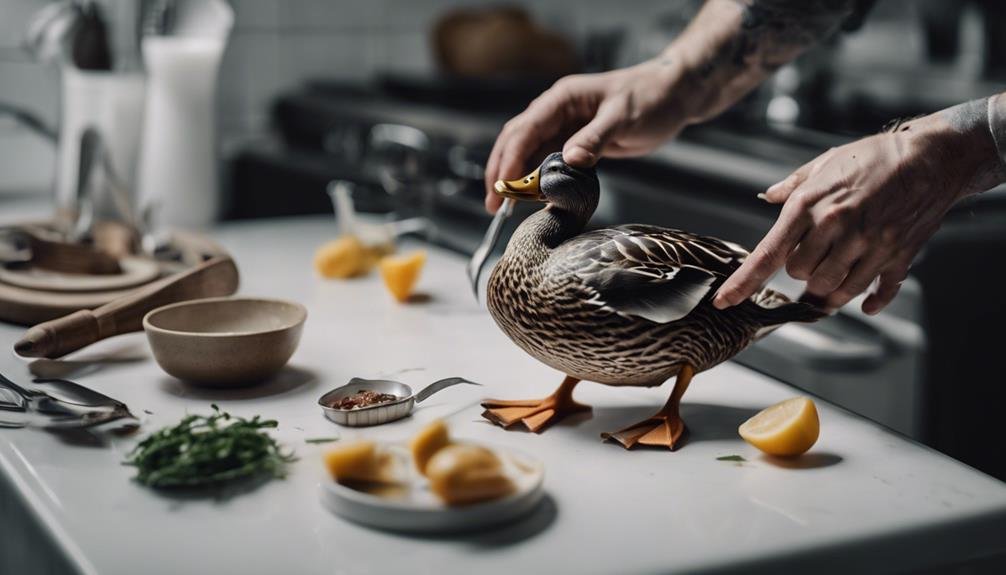Unseasonable warmth is rewriting the rules of duck hunting, disrupting traditional behavior and forcing hunters to adapt and innovate to remain successful. As temperatures soar, ducks alter their daily routines, feeding at night and flying from refuges to private land. Traditional tactics no longer apply, and scouting becomes essential to understanding these changes and finding success. By identifying unusual feeding and flying patterns, hunters can uncover hidden gems and capitalize on the duck migration. As the rules of the game change, hunters must adapt to the whims of Mother Nature to fill their bags – and the secrets to success lie just beyond.
Key Takeaways
- Unseasonable warmth affects duck behavior, altering their feeding and flying patterns, making traditional hunting tactics ineffective.
- Scouting becomes crucial to understanding these changes and adapting to the whims of Mother Nature for a successful season.
- Warm weather drives ducks to focus on avoiding hunting pressure, altering their daily routines, and feeding strictly at night or on private land.
- Effective scouting requires morning, noon, and night reconnaissance to uncover unusual feeding and flying habits and make informed decisions.
- Hunters must adapt their strategies to capitalize on unusual patterns, targeting less pressured ducks in unconventional spots, such as small ponds or shallow wetlands.
Understanding Unseasonable Warmth
As the planet continues to experience unprecedented warmth, with November 2020 being the warmest month in 142 years of recorded history, duck hunters must adapt to the repercussions of unseasonable temperatures on duck behavior. Warm hunts, a new norm, demand a shift in strategy. Duck diaries, once filled with predictable patterns, now require a fresh perspective. Unseasonable warmth translates to less active ducks, and unusual feeding and flying patterns. Scouting becomes essential to understanding these changes and finding success. Hunters must be prepared to adapt to the whims of Mother Nature, as warm weather wreaks havoc on traditional hunting tactics. By embracing this new reality, hunters can still fill their bags and enjoy a successful season.
Pattern Changes in Warm Weather
Warm weather's impact on duck behavior is multifaceted, but one of the most significant changes hunters face is the dramatic shift in pattern, as ducks become more focused on avoiding hunting pressure and adapting to the unusual temperatures. In warm ducklands, ducks alter their daily routines, often feeding strictly at night or only flying from refuges to private land. Morning flights, typically a hunter's best bet, can become scarce as ducks adapt to the warm weather. This shift in pattern requires hunters to adapt their strategies, scouting for unusual feeding and flying patterns to stay ahead of the game. By understanding these changes, hunters can increase their chances of success, even in the warmest of weather conditions.
Scouting for Unusual Patterns
During periods of unseasonable warmth, scouting for unusual patterns becomes essential, as ducks develop unique feeding and flying habits that can only be uncovered through diligent reconnaissance. As the warm weather impact affects duck migration, understanding these unusual patterns is vital for a successful hunt. Scouting allows hunters to identify the altered habits of ducks, such as feeding strictly at night or flying only from refuges to private land. By recognizing these patterns, hunters can adapt their strategy to increase their chances of success. Effective scouting requires morning, noon, and night reconnaissance to uncover the hidden habits of ducks in warm weather. This knowledge enables hunters to make informed decisions and capitalize on the unusual patterns that arise during periods of unseasonable warmth.
Finding Less Pressured Ducks
When the duck population becomes accustomed to hunting pressure, they often seek refuge in areas that receive less attention, making it imperative for hunters to identify and target these less pressured ducks. As duck migration patterns shift in response to unseasonable warmth, hunters must adapt by finding alternative locations with reduced hunting pressure. These areas often produce more active ducks, as they feel safer and less disturbed. By scouting for these hidden gems, hunters can capitalize on the duck migration and enjoy more successful hunts. By avoiding popular hunting spots and seeking out less pressured areas, hunters can increase their chances of bagging their limit, even in the face of warm weather and heavy hunting pressure.
Success in Unconventional Spots
In unconventional spots, such as small, isolated ponds or shallow wetlands, hunters can uncover hidden gems that are often overlooked by the masses, yet teeming with active ducks seeking refuge from the crowds. These unconventional duck habitats often provide an oasis for ducks escaping the pressure of popular hunting spots. Weather trends, such as unseasonable warmth, can alter duck behavior, driving them to seek shelter in these secluded areas. By venturing into these unconventional spots, hunters can capitalize on the duck's desire for seclusion, increasing their chances of success. By adapting to the changing weather trends and duck behavior, hunters can find success in these often-overlooked areas, reaping the rewards of their scouting efforts.
Jump-Shooting Small Ponds
One of the most effective ways to bag ducks in unseasonable warmth is to jump-shoot small ponds, where the ducks' altered behavior makes them more susceptible to clever hunters. Small ponds offer a unique advantage, as they provide better sneaking opportunities, especially when combined with dam shooting. Pond hopping, a technique that involves moving from one small pond to another, can also increase your chances of success. By targeting these smaller bodies of water, you can avoid the crowds and pressure that often come with larger hunting spots. Additionally, jump-shooting small ponds allows for easier shooting and retrieval, making it a fun and effective way to get birds. By adapting to the ducks' changed behavior, you can capitalize on this opportunity and bring home the bacon.
Adapting to Unusual Behavior
Ducks' altered behavior in unseasonable warmth demands a flexible hunting strategy, as their unusual feeding and flying patterns require hunters to adapt and respond accordingly. As weather patterns deviate from the norm, ducks adjust their behavior, making it essential for hunters to be agile in their approach. This might involve shifting hunting times, exploring new locations, or modifying decoy spreads.
| Duck Behavior | Weather Pattern | Hunting Strategy |
|---|---|---|
| Unusual Feeding | Warm Temperatures | Adjust Hunting Times |
| Altered Migration | Unseasonable Weather | Explore New Locations |
| Nighttime Feeding | Warm Spells | Modify Decoy Spreads |
Expert Advice for Warm Weather
When warm weather disrupts the traditional patterns of duck behavior, expert hunters stress the importance of adapting to these changes and offer valuable insights on how to adjust hunting strategies accordingly. Dan Morrison, a seasoned hunter, emphasizes the need for thorough scouting, morning, noon, and night, to understand the unusual patterns that emerge during warm weather. Mikal Gowins agrees, highlighting the importance of scouting and hunting ponds with fewer ducks, where pressure is minimal. According to these experts, getting away from hunting pressure is vital, as less pressured ducks are more likely to be active even in warm temperatures. By adapting to these changes and adjusting hunting strategies, hunters can increase their chances of success during warm weather duck migration.
Frequently Asked Questions
What Are the Best Decoy Spreads for Jump-Shooting Small Ponds?
For jump-shooting small ponds, opt for a sparse decoy spread with 6-12 decoys, focusing on decoy density and spread patterns that mimic natural habitats, such as a "U" or "J" shape, to entice wary ducks and increase hunting success.
Can You Successfully Hunt Ducks During the Warmest Part of the Day?
"While the sun beats down, ducks seek shade, making mid-day hunting challenging. Employing mid-day strategies, such as targeting shaded areas and using warmth tactics like decoys and calls, can increase success during the hottest part of the day."
How Do I Adapt My Hunting Strategy for Different Weather Conditions?
To adapt your hunting strategy for different weather conditions, consult weather forecasting reports to anticipate wind patterns, temperature fluctuations, and precipitation, allowing you to adjust your scouting, hunting, and flying patterns accordingly.
What Are Some Signs of Duck Activity in Unseasonably Warm Weather?
In unseasonably warm weather, look for signs of duck activity such as altered feeding patterns, increased nocturnal behavior, and altered water conditions, like reduced pond levels, which can indicate concentrated duck behavior.
Are There Any Specific Duck Species More Active During Warm Weather?
During unseasonable warmth, some duck species exhibit increased activity, such as Mallards, which continue their migration patterns, while Wood Ducks, known for their skittish nature, become even more elusive, presenting unique challenges for hunters.
Conclusion
Ultimately, warm weather's disruption of duck hunting's status quo necessitates adaptability and innovation. As ducks deviate from traditional patterns, hunters must similarly diverge from conventional strategies. By embracing the unpredictability of unseasonable warmth, hunters can transform what would otherwise be a frustrating experience into an opportunity for creative problem-solving and, ultimately, success.









